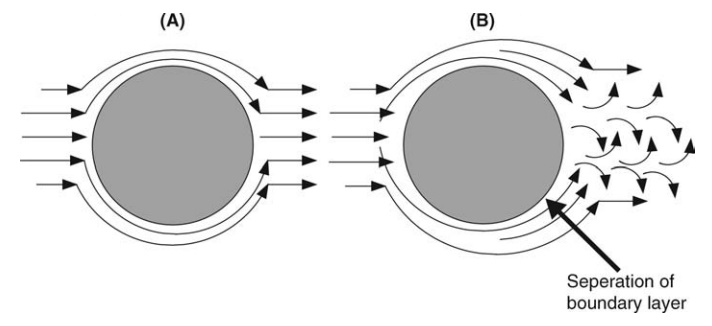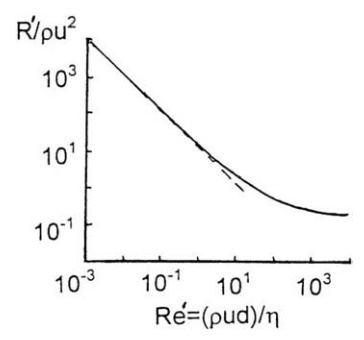Motion of Bodies in a Fluid
| Home | | Pharmaceutical Technology |Chapter: Pharmaceutical Engineering: Fluid Flow
When a body moves relative to a fluid in which it is immersed, resistance to motion is encountered and a force must be exerted in the direction of relative body movement.
MOTION OF BODIES IN A FLUID
When
a body moves relative to a fluid in which it is immersed, resistance to motion
is encountered and a force must be exerted in the direction of relative body
movement. The opposing drag force is made up from two components, viscous drag
and form drag. This may be explained by reference to Figure 2.11, which
describes the flow past a body, in this case, a cylinder with axis normal to
the page, by means of streamlines. As mentioned, streamlines are hypothetical
lines drawn tangential at all points to the motion of the fluid. Flow past the
cylinder immobilizes the fluid layer in contact with the surface, and the
induced velocity gradients result in shear stress or viscous drag on the
surface. The crowding of streamlines on the upstream face of the cylinder, the
flow pattern, and momentum changes on the downstream surface must be exactly
reversed. This is shown in Figure 2.11A, and the entire force opposing relative
motion of the cylinder and fluid is viscous drag. However, conditions of
increasing pressure and decreasing velocity that exist on the downstream surface
may cause the boundary layer to separate. The region between the breakaway
streamlines—the wake—is occupied by eddies and vortices, and the flow pat-tern
shown in Figure 2.11B is established. The kinetic energy of the accelerated
fluid is dissipated and not recovered as pressure energy on the downstream
surface. Under these conditions, there is a second component to the force
opposing relative motion. This is known as form drag. Its contribution to the
total drag increases as the velocity increases.

FIGURE 2.11 Flow of fluid past a cylinder (A) laminar and (B) turbulent.
Once
again, viscous and inertial forces are operating to determine the flow pattern
and drag force on a body moving relative to a fluid. Reynolds number, which
expresses their ratio, is used as a parameter to predict flow behavior. The
relation between the drag force and its controlling variables is presented in a
manner similar to that employed for flow in a pipe. If we consider a sphere
moving relative to a fluid, the projected area normal to flow is πd2/4, where d is the diameter of the sphere. The
drag force acting on the unit projected area, R’, is determined by
the velocity, u, the viscosity, η, and the density, ρ, of the fluid, and the diameter of
the sphere, d. Dimensional analysis
yields the relation

The
form of Reynolds number, Re’, employs the diameter of the sphere
as the linear dimension. With the exception of an analysis at very low Reynolds
numbers, the form of this function is established by experiment. Results are presented
on logarithmic coordinates in Figure 2.12. When Re’ ≤ 0.2, viscous
forces are solely responsible for drag on the sphere and equation (2.21) is

This
is the normal form of Stokes’ law.

FIGURE 2.12 R’/ρμ2 versus Reynolds number for a smooth sphere.
At larger Re’ values, the
experimental curve progressively diverges from this relation, ultimately
becoming independent of Re0
and giving a value of R’/ρu2 = 0.22. As Re’ increases, the form
drag increases, ultimately becoming solely responsible for the force opposing
motion.
For nonspherical
particles, the analysis employs the diameter of a sphere of equivalent volume.
A correction factor, which depends on the shape of the body and its orientation
in the fluid, must be applied.
An
important application of this analysis is the estimation of the speed at which
particles settle in a fluid. Under the action of gravity, the particle
accel-erates until the weight force, mg,
is exactly balanced by the opposing drag. The body then falls at a constant
terminal velocity, u. Equating weight
and drag forces gives

where
ρ is the density of
the particle.
For
a sphere falling under streamline conditions (Re’ < 0.2), R’ = ρu2·12/ Re’. Substituting in
equation (2.23), we obtain

This
expression follows more simply from the equation mg - 3πdηu.
Related Topics
